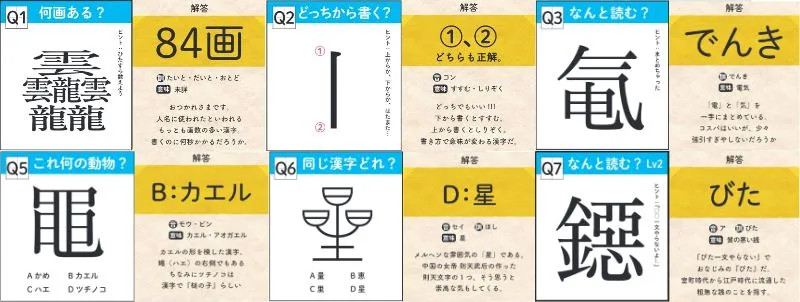
Three dragons and three clouds…A straight line…An upside-down “child”…What could they mean?
The Japanese language is written using three different systems: hiragana and katakana, which are phonetic, and kanji, which is made up of individual characters, each with its own meaning and a pronunciation that changes depending on the context. If you have studied Japanese, you’ll know that kanji is one of the most difficult parts of learning the language.
That’s true for Japanese people as well. In fact, did you know that there are kanji so old or so bizarre that no one can recognize them? Take, for example, this character:
Though it looks like some kind of work of abstract art, this is a Japanese kanji that uses twelve of the “kuchi” radicals. “Radicals” are the individual parts of a character that each have meaning, and “kuchi” means “mouth.” Many people would say that this character, made up of 12 “mouth” radicals, is not a real character, but it is–it’s even listed in Japanese dictionaries!
You can find an example of its use in Uso Jidzukushi, a work by Edo-era novelist Shikitei Sanba. Have you figured out what it means? It’s read as “oshaberi,” which means “chatterbox” or “talkative”. How appropriate!
There are lots of other bizarre kanji out there. For example, the one shown above is made up of 84 strokes (the number of movements of a brush or pen needed to write the character), which is apparently the most out of any Japanese character. It’s composed of three characters for “cloud” and three characters for “dragon” mixed together. No one knows what it originally meant, but it was apparently used in people’s names.
On the flip side, there’s this character, shown below, that’s just a single vertical line. But though it looks simple, it’s really not. When written from the bottom up, it means “to proceed”, but when written from the top down (as pictured below), it means “to withdraw”.
Some strange characters make a lot of sense, once you think about them. For example, the character for “child,” (子), turned upside-down was once used as “to be born”–since children are born head-first.
If this piques your interest, you’ll love the new book “Kimyona Kanji” (奇妙な漢字 “Strange Kanji”), which is where the above excerpts were taken from.
▼ Written by Kotoku Sugioka, the Japanese book was published by Poplar and released on January 11.
It’s a must-see for fans of kanji or linguistics. There are altogether 468 unusual kanji to explore, so it looks set to be a very interesting read! You can find it on Amazon Japan or Poplar’s official website for 990 yen (US$7.58).
And if you’re looking for more Japanese language fun, here are some really cool phrases to add to your vocabulary, or you can learn 11 different ways to say “father” in Japanese.
Source, images: PR Times
● Want to hear about SoraNews24’s latest articles as soon as they’re published? Follow us on Facebook and Twitter!
[ Read in Japanese ]